New Chromatography Columns and Accessories at Pittcon 2009: Part I
LCGC North America
Ron Majors brings readers his yearly review of all that was new and innovative at the annual Pittsburgh Conference.
Pittcon 2009, the 60th Pittsburgh Conference on Analytical Chemistry and Applied Spectroscopy, was held in the massive McCormick Place in Chicago, Illinois, on March 8–13, 2009, the sixth time the Conference has been held there. This year's event hosted nearly 1000 instrument manufacturers and laboratory suppliers in more than 2200 booths. In addition to attending the exposition, the conferees listened to 2500 technical presentations, checked numerous company seminar rooms, or attended one or more of 120 short courses.

Ronald E. Majors
Undoubtedly, Pittcon remains the most important yearly international analytical exhibition, where companies introduce their latest instruments, instrument accessories, software, columns, sample preparation equipment, and other consumable products. Because many past attendees have purchased one or more new products within three months after attending the show, most exhibitors attempt to maximize their booth traffic to meet as many potential customers as possible.
The purpose of this report is to provide information about many of the new separation consumables and accessory products that will be displayed at Pittcon 2009. In some cases, products that were introduced during 2008 but after Pittcon 2008 (1,2) might be included for reasons of completeness. The information is based upon manufacturers' responses to a questionnaire mailed in December 2008. Because of space limitations and the fact that some manufacturers did not respond to the questionnaire, this report cannot be considered an exhaustive listing of all new products that were introduced in Chicago. However, over the years, these Pittcon introduction summaries have provided a good source of information that would be difficult for one individual to gather during the four days of the exhibition. In addition, the products introduced have shown definite correlations to current research, development, and application activity in the separation sciences.
As in previous years, columns and other products recommended by their manufacturers primarily for biomolecule separations or sample preparation are denoted in the tables with the designation BIO. Some of these products can be used for general high performance liquid chromatography (HPLC) separations as well, but their main emphasis is for biological samples.
In this month's coverage, I will describe new introductions in the areas of HPLC: reversed-phase, normal- and bonded-phase, ion-exchange and ion, size-exclusion, and large- and preparative-scale chromatography; specialty chromatography columns; and thin-layer chromatography (TLC). Next month, I will look at gas chromatography (GC) columns, sample preparation products, and hardware, accessories and kits for chromatography, and sample preparation.
Trends and Highlights
General: This year, I observed that there was a continued trend in high-throughput techniques, especially in the HPLC and sample preparation areas. More devices and instrumentation that support automation made their appearance, and autosamplers with sample preparation functionality have been reappearing. Many application-specific columns for HPLC and GC and various devices for solid-phase extraction (SPE) and sample preparation were introduced. Again at Pittcon, a considerable number of new accessories, hardware, software, and devices were introduced that could make chromatographic laboratories more productive.
HPLC columns: At Pittcon 2009, reversed-phase HPLC maintained its dominance and over half of the introductions were the ever-popular C18 phase. Hydrophilic interaction chromatography (HILIC) columns also were quite evident. Polymer-based HPLC columns are ever-increasing and now dominate the ion-exchange and size-exclusion modes. Mixed-mode columns have now established themselves as an alternative to single-phase columns. Mixed mechanisms give rise to subtle (and sometimes substantial) selectivity changes compared to regular alkyl phases. From an applications standpoint, chiral and protein–peptide columns dominated the introductions.
Gas chromatography: Ultra-inert GC columns are the latest differentiating feature in the marketplace. New porous layer open tubular (PLOT) column introductions show that the separation of small molecules and gases is still of interest. A selection of application-specific columns, especially for biodiesel and bioethanol separations and regulated methods, show that interest in specialty GC columns is still prevalent.
Sample preparation: A variety of formats in SPE were introduced: cartridges, pipette tips, and 96-well plates and some interesting new SPE application-specific phases for environmental and biological fluid samples. Combination products of protein precipitation and SPE were introduced to provide cleaner, phospholipid-free extracts of biofluids for LC with tandem mass spectrometry (LC–MS-MS) analysis. Additional QuEChERS kits made their appearance, for simple, low-cost sample preparation for the analysis of pesticides in fruits and vegetables. Some unique approaches to sample filtration are included.
Accessories: With the current shortage of acetonitrile, solvent recyclers could become an important accessory. Products to make method development simpler in HPLC were introduced including software, column selector, and a low-pressure solvent mixer. Some convenient GC accessories such as a new hydrogen generator, leak detector, semiautomated vial cap crimper, and low gas alarm system were seen at the show. Some useful semiautomated sample preparation devices like evaporators, digesters, mixers, concentrators, and aspirators take some of the drudgery out of sample preparation.
Autosamplers for GC and LC with sample preparation capabilities are making their appearance.
New Series of HPLC Columns and Packings
Each year, manufacturers introduce entire new families of HPLC columns at Pittcon. For the sake of brevity, I have elected to cover those series here instead of listing each column under individual headings in the modes' tables. In some cases, the series are extensions of existing products but cover additional phases while in other cases, the families are entirely new to the market.
Silicycle (Quebec, Quebec, Canada) is a company specializing in silica-based columns and catalysts. This year, the company introduced a line of SiliaChrom HPLC columns for analytical HPLC. The packings, based upon high-purity, spherical 3- and 5-μm diameter silica with 100–150 Å pores, are currently available for reversed-phase (C18, phase coverage 10–22% carbon), adsorption, and HILIC. Columns with 2.1- and 4.6-mm internal diameters and lengths from 30 to 200 mm are available. Varian (Palo Alto, California) introduced its SepTech bulk media that are optimized for preparative to process chromatography. Based upon 10-μm high-purity silica with low metal content, the media are available in two pore sizes, ST 60 Å and ST 150 Å. The media are suitable for small molecules and larger natural compounds and biomolecules, respectively. Their bonding chemistry with endcapping provides optimum ligand density (3.5 and 3.8 μmol/m2 for ST 60 and ST 150, respectively; corresponding carbon loadings are 25% and 15%) for high-capacity separations of hydrophobic and hydrophilic compounds. Bulk quantities from 100 g to 25 kg can be purchased as standard.
Another silica gel supplier, Grace Davison Discovery Sciences (Deerfield, Illinois), introduced its VisionHT LC family of columns. A broad range of phases suitable for reversed-phase (C18), adsorption, and HILIC modes in particle sizes 1.5, 3.0, 5, and 10 μm were shown. Such a range of particle sizes allows seamless method transfer between various column configurations in analytical and preparative chromatography. The phases are based upon silica particles with 100- and 120-Å pores. Column dimensions are 10–250 mm x 1–10 mm. Zirchrom Separations (Anoka, Minnesota), best known for its zirconia-based columns, has introduced 2-μm versions of all of their phases. All products have a pore size of 300 Å. Column dimensions cover the capillary to analytical range; custom columns can be provided. Zirchrom also provides bulk material for those who wish to pack their own columns.
Chiral Technologies (West Chester, Pennsylvania), a supplier of chiral columns, has extended its popular line of Chiralpak and Chiralcel columns with the addition of added phase chemistries. The columns are based upon 3- and 5-μm spherical silica gels; the pore size of over 1000 Å is required for the successful coating of the polysaccharide (cellulose or amylase) chiral stationary phases. These columns are all useful for separations in the reversed-phase mode. Various column dimensions are available including 50, 100, and 250 mm x 4.6 mm. Chiralcel OZ, with a 5-μm particle size, has a chiral selector based upon cellulose tris-(3-chloro-4-methylphenylcarbamate), while Chiralcel OD-3R has the same chiral selector but is based upon a 3-μm higher efficiency silica. ChiralPak AZ columns, packed with 5-μm particles, have a chiral selector amylose tris-(3-chloro-4-methylphenylcarbamate) while the ChiralPak AY columns, also packed with 5-μm particles, have the chiral selector amylase tris-(3-chloro-4-methylphenylcarbamate). Finally, ChiralPak AD-3R, packed with 3-μm particles, has the chiral selector amylase tris-(3,5-dimethylphenylcarbamate). Although the chiral selectors appear to be quite similar, such diverse functionalities can provide subtle differeneces in enantiomeric selectivity. To illustrate the separation power of chiral specific phases, Figure 1 shows the separation of the metolachlor (Novartis), a chloroacetamide herbicide which is the second most widely used herbicide in the world. Its structure is also shown in Figure 1. The unusual functionalization pattern of this molecule renders the amine functionality extremely sterically hindered. As a consequence, metolachlor has two chiral elements: a chiral axis (atropisomerism) and a stereogenic center, giving rise to four stereoisomers, each of which undergoes enantioselective degradation in agricultural runoffs. So the ability to separate the isomers in order to follow this degradation is important. Note that the separation of these four stereoisomers is extremely difficult with most chiral stationary phases. The Chiralpak AY-H was able to provide nearly a baseline separation using an ethanol-hexane mobile phase.
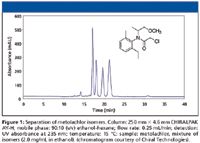
Figure 1
Reversed-Phase Chromatography
As usual, many new reversed-phase columns were introduced at Pittcon 2009 (see Table I). If one also adds all the reversed-phase columns covered in the new series and in specialty columns (Table II), one can see clearly the dominance of this operational mode. Over 53 new reversed-phase columns were added to the huge numbers that already exist from past introductions. Silica-based bonded phase columns dominated the introductions again (75%) but polymer-based reversed-phase columns (20%) were more visible this year. Polymer columns are more rugged with respect to pH range and solvent compatibility and can go to higher operating temperatures. For example, the ProSwift RP-4H column from Dionex can be rinsed with 1 M sodium hydroxide and the Shodex ET-RP1 column can withstand temperatures up to 150 °C for extended periods of time.
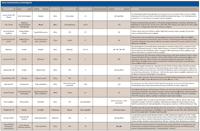
Table I: Reversed-phase chromatography
The C18 (octadecylsilane) functionality year proved again the most popular with over half of all reversed-phase columns being based upon this alkyl phase. However, this phase is not always the optimum for all separations and C4, C8, polar-embedded C8 and C18, phenyl, biphenyl, mixed phases, polymer-coated, silica-hydride, and cyanopropyl phases were made available by various suppliers to present selectivity alternatives. The HILIC columns that have some hydrophobic interaction possibilities are found in the Specialty column Table II. This year one silica-based monolith and one polymer-based monolith were introduced.
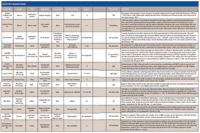
Table II: HPLC specialty columns
Although C18 is the phase leader, mixed-mode reversed phases have come into popularity in recent years. Phenyl hexyl columns are one example; this year Advanced Chromatography Technologies (Aberdeen, UK) introduced a C18 combined with a phenyl. Possessing both hydrophobic and aromatic functionality, such columns can provide a different selectivity than either phase alone. Perhaps compounds that can be unresolved on a single stationary phase functionality could be better separated on such a mixed-phase column. Due to the addition of a polar moiety into an alkyl chain, polar-embedded stationary phases also give dramatically different selectivities than alkyl only phases; two new ones were introduced at Pittcon 2009.
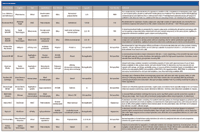
Table II: Continued
As far as particle sizes go, the workhorse columns are now packed with 3-μm particles. This trend has been evident over the last few years as shorter columns with smaller particles come into favor. In addition, the 2- and sub-2-μm particles are still being introduced because their use in fast, high-throughput columns is now well established. At least four companies introduced reversed-phase columns with these smaller particles. Some suppliers still feel that particles in the 2–3 μm diameters offer improved efficiency over 3–3.5 μm particles but lower pressure drops than the sub-2-μm columns. The superficially porous particles (SPP) of 2.7-μm diameter offer lower pressure with the same efficiency as the sub-2-μm columns. There seems to be growing interest by researchers to try out these SPP so it will be of interest to see what marketshare they can command. Although originally thought to have much lower surface area and therefore sample capacity, the SPP columns show only around 25% less capacity than a totally porous particle of the same diameter.
Normal-Phase and Adsorption Chromatography
The term "normal-phase chromatography" implies that a nonpolar mobile phase and a polar stationary phase is used for the separation but columns with polar functional groups like cyano, amino, and diol have been used for other modes such as reversed phase, hydrophilic interaction, and ion exchange. This year, two companies introduced columns that were suited for bonded normal-phase chromatography: Imtakt (Kyoto, Japan) and Fortis (Neston, Cheshire, UK).
Imtakt is represented in the U.S. by Silvertone Sciences (Philadelphia, Pennsylvania). Its Unison UK-Amino column is based upon a 3-μm silica with an aminopropyl bonded phase. When used in aqueous solution under acidic conditions under which the amino group is protonated, the column functions as a weak anion exchanger and when used with water–acetonitrile mobile phases for sugar separations, often with low UV detection, it functions in the HILIC mode. It also can function as a mixed-mode phase under the appropriate experimental conditions. The pH range for the Unison UK column is 2–9. The company's cartridge design columns are available from nanoLC to preparative sizes. Guard columns are also available.
Fortis, a relatively new company in the columns business, established in 2005, has been expanding its portfolio and this year added a cyano column. Particles range from 2.1, 3.0, to 5 μm and can be packed into just about any analytical internal diameter (for example, 2.1, 3.0, and 4.6 mm). A prepacked guard column also is available. Due to the base silica's relatively high surface area (for example, 380 m2/g), the column shows rather high loadability. Separations of explosives, pesticides, and polar analytes by normal-phase chromatography have been demonstrated.
Ion-Exchange and Ion Chromatography
In addition to the ion-exchange columns introduced as part of a family and the mixed-mode columns shown in Table III, two companies, OraChrom (Woburn, Massachusetts) and Tosoh Bioscience (Montgomeryville, Pennsylvania) introduced new ion-exchange columns. All of these columns were based upon polymeric packings; in general, silica gel-based packings do not seem to stand up to the rigorous mobile phase conditions often used in ion-exchange separations.
The TSK-Gel STAT columns from Tosoh Bioscience are based upon polymethacrylate chemistry, which provides a hydrophilic polymer base material, making them more suitable for biomolecules in aqueous mobile phases. The polymer has been functionalized with quaternary ammonium (DNA-STAT), carboxymethyl (CM-STAT) and sulfopropyl (SP-STAT) to give strong anion, weak cation, and strong cation exchange character, respectively. Particle sizes of 5, 7, and 10 μm are available. Each of the STAT series columns is suited to a specific type of biomolecule separations including separation of DNA fragments, proteins including PEGylated proteins, peptides including digests, monoclonal antibodies, various protein aggregates, and nucleic acid constituents. The unique feature of the TSK-Gel STAT surface is its open network of multilayered ion-exchange groups. This feature, combined with a relatively large particle size, results in an improved loading capacity, low operating pressure, and good efficiency for both high and low molecular weight molecules. Static binding capacity is increased through novel bonding chemistry even though the surface area of the larger particles is decreased slightly.
The OraChrom offerings are based upon its hard, gigaporous Styros PS-DVB methacrylate copolymers that the company terms a "simulated monolith." Columns packed with these materials show a low-pressure drop due to large flow-through pores, somewhat reminiscent of a polymeric monolith column. The chemistries are based upon covalent bonding of various functionalities with the polymer surface. This year the company has expanded its line with the addition of three new anion exchangers: Styros ANX based upon primary and secondary amine functionality (weak anion exchanger); Styros DEAE based upon diethylaminoethyl functionality (weak anion exchanger); and Styros SAX based upon a quaternary amine functionality (strong anion exchanger). The columns are well suited for the separation of various biomolecules by anion-exchange techniques. Columns of PEEK and stainless steel construction with 1–250 mm x 0.01–20 mm dimensions are available, as are guard columns.
Size-Exclusion Chromatography
In the past few years, only a few new size-exclusion chromatography (SEC) columns have been introduced at Pittcon. That does not mean that SEC is not a highly practiced separation mode. It is a standard technique for the separation and characterization of organic polymers, both organic- and water-soluble. In addition, the mode is used widely for the separation of proteins and other biopolymers, sometimes known as gel filtration chromatography. Two companies introduced columns for SEC: Jordi Labs (Bellingham, Massachusetts) and Sepax Technologies (Newark, Delaware).
Jordi, a company specializing in polymeric packings, introduced its xStream H2O column for the separation of common and unusual polar and cationic polymers, especially dextrans, polysaccharides, and vinyl ether–maleic acid copolymers in pure water eluents. The column can function in any range of mobile phases including 100% aqueous, 100% organic, or any mixture of solvents. Based upon polyamide chemistry, the column has been used with tetrahydrofuran, chloroform, DMSO, DMAC, and DMF and HFIP; the latter in cases in which sample-column interactions have been minimized, thereby providing excellent resolution of nylons and PET polymers. Other polymers separated include phenoxy resins, poly(n-butyl methacrylate), polycaprolactone, several styrenic polymers, PMMA, and other methacrylic polymers. In addition to a wide variety of packed guard, analytical, and preparative columns, Jordi also will provide bulk packing.
Sepax introduced its silica-based column line called SRT Zenix, designed for aqueous mobile phase systems. The columns are recommended for the SEC separation of biological molecules, water-soluble polymers, nanoparticles, biological bacteria, and viruses. The stationary phase, on 3-μm silica, is hydrophilic and neutral with a coating of nanometer thickness. Two pore sizes, 150 and 300 Å, are available; high pore volume provides high capacity and high resolution; compatible with and stable in a wide range of salt concentrations (10 mM to 2.0 M). The SRT Zenix columns comes in standard dimensions of 300 mm x 2.1, 4.6, and 7.8 mm, but special sizes are available on request; bulk packing also can be purchased.
Thin-Layer Chromatography
TLC and HPTLC (high performance TLC) are simple techniques that many chromatographers overlook, even when they need only a cursory separation or purity check. Sorbent Technologies (Atlanta, Georgia) has made the technique easier by packaging a method development 12-pack of standard HPTLC plates. The company's Plate Spice Rack consists of two each of six unique silica-coated plates (10 cm x 10 cm) with the following phases: amino, cyano, C18, C2, diol, and silica gel. The "try before you buy" package saves money by cutting the cost of unusable full boxes. The plates are glass-backed and have an embedded fluorescent indicator activated by a 254-nm UV lamp for viewing separated spots.
Specialty HPLC Columns
Specialty columns are HPLC columns that have been developed for specific separations that are difficult to achieve on a standard column. However, sometimes manufacturers will use a standard column but test it specifically for a certain class or compounds and provide a recommended set of chromatographic conditions. In some cases, the specialty column comes as part of a "total solution" kit with reagents, standards, and a method. Most specialty columns will be delivered with a test chromatogram from an analysis performed at the factory before shipment and some are guaranteed for a specific separation. Table II shows the 27 specialty columns that were presented at Pittcon 2009. Silica gel-based columns were again a distinct majority but polymer-based specialty columns were clearly in evidence.
As depicted in Table II, the biggest specialty column application area was the separation of proteins and other large biomolecules. Columns of this type ranged from polymeric monoliths with various ionic and affinity functionalities to "simulated" monoliths with gigapores, to conventional wide pore silica and silica hydrides with 300-Å pores. Such large pores are needed to allow large biomolecules to diffuse inside of the particles to interact with specific ligands. Monolith columns provide lower pressure drops than particulate-based columns, and being polymeric, can withstand more aggressive solvent treatment. To illustrate the use of monolithic columns, Figure 2 shows the use of the BIA Separations (Ljubjana, Slovenia) two-column separation kit for plasmid DNA starting from a bacterial lysate obtained by an alkaline lysis procedure. After adjustment and clarification, the lysate is injected onto the first column (CIM DEAE, weak anion exchanger), where impurities were removed and the pDNA peak collected and then reinjected onto column 2 (CIM C4 HLD, hydrophobic interaction mechanism), where the supercoiled plamid DNA is separated from the open circular form, genomic DNA and remaining endotoxins.
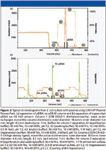
Figure 2
A most interesting protein column introduced by Invenca (Simpsonville, South Carolina) consisted of bundles of tightly packed nonporous fibers inside of a standard column format. This bundled fiber column is based upon the work of Kenneth Marcus and coworkers from Clemson University. Affinity chromatography is one of the more selective techniques for IgG and other monoclonal antibody purification. Protein A is one of the favored affinity ligands for this separation because it binds to the Fc portion of IgG. Three companies introduced products for monoclonal antibody separations using protein A. In addition, immobilized metal affinity chromatography (IMAC) is also a very selective approach for specific proteins such as His-tagged proteins. Natrix Separations' (Burlington, Ontario, Canada) Quantum media, which combines the binding capacity of resins with the ease of use of membranes, can perform IMAC separations at low pressures.
Similar to last year (1), HILIC columns were prominent in the area of specialty columns. Some HILIC columns were featured in the new series section as part of a family but in Table II, additional HILIC columns based upon bare silica, silica hydride, and PS-DVB-methacrylate copolymers with polar functional groups were presented for the first time at Pittcon 2009. HILIC is a separation technique for highly polar analytes that gets around some of the problems associated with reversed-phase chromatography such as low retention or phase collapse (dewetting). HILIC uses a polar stationary phase such as bare silica gel, polar bonded phase (for example, diol), or certain mixed-mode or zwitterionic phases. Operating conditions usually require a high percentage of nonpolar mobile phase, similar to the requirements for normal phase chromatography. However, unlike normal-phase chromatography, which uses nonpolar solvents like hexane and methylene chloride and tries to exclude water from the mobile phase, HILIC requires some water in the mobile phase to maintain a stagnant enriched water layer on the packing surface into which analytes can partition selectively. In addition, water-miscible organic solvents are used. Under HILIC, polar analytes are well retained and are eluted in order of increasing hydrophilicity. HILIC is especially favored by mass spectroscopists because ionization efficiency often is enhanced in organic solvents and the presence of lower concentrations of volatile buffer salt compared to reversed-phase chromatography. Most HILIC columns are silica-based, but Styros HILIC is a PS-DVB-methacrylate-based packing but with hydroxyl functionality. A simple separation illustrating the HILIC mode is shown in Figure 3. Typical of HILIC, the elution order is reversed from what one would expect of a reversed-phase column. Naphthalene is eluted before uracil and cytosine. The MS-compatible mobile phase is mostly organic at 90:10 acetonitrile–0.2 M aqueous ammonium formate.
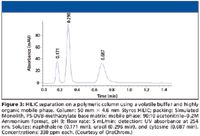
Figure 3
Chiral separations are still in the forefront, especially in the pharmaceutical industry. Separations using HPLC and supercritical fluid chromatography (SFC) can be achieved by a variety of chiral stationary phases (CSPs). A total of 10 new chiral columns were introduced at Pittcon 2009 (see Table II and new series). The most popular are those based upon modified polysaccharides (amylose- or cellulose-based) phases. Because many analytical separations are scaled up to obtain larger quantities of purified enantiomers, preparative particle sizes are frequently part of column introductions.

Companies Listed in This Column
Flash chromatography columns and media are included as specialty columns because they usually are designed for specific instruments that provide low-pressure solvent delivery. Flash chromatography is the modern equivalent to the gravity-fed columns of yesteryear, albeit with more reproducible flow control, automation features, and on-line detection and fraction collection. Recent flash columns are becoming more universal and aside from inorganic sorbents such a silica gel or alumina, now have reversed-phase, low-pressure columns. Two companies introduced new flash columns.
Acknowledgment
I would like to thank the manufacturers and distributors who kindly furnished the requested information in advance of Pittcon 2009, thus allowing a timely report on new product introductions. For those manufacturers who would like to be considered for inclusion into Pittcon 2010 coverage, please send the name of the primary company contact, the mailing address, FAX, and E-mail address to Patrick Kempf, Managing Editor, LCGC North America, c/o Advanstar Communications, 485 Rte. 1 South, Bldg. F, Iselin, NJ 08830, Attn.: Pittcon 2010 "Column Watch."
Ronald E. Majors
"Column Watch" Editor Ronald E. Majors is Senior Scientist, Columns and Supplies Division, Agilent Technologies, Wilmington, Delaware, and is a member of LCGC's editorial advisory board. Direct correspondence about this column to "Column Watch," LCGC, Woodbridge Corporate Plaza, 485 Route 1 South, Building F, First Floor, Iselin, NJ 08830, e-mail lcgcedit@lcgcmag.com.
References
(1) R.E. Majors LCGC 26(3) 238–253 (2008).
(2) R.E. Majors LCGC 26(4) 334–350 (2008).
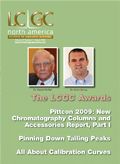
New Study Reviews Chromatography Methods for Flavonoid Analysis
April 21st 2025Flavonoids are widely used metabolites that carry out various functions in different industries, such as food and cosmetics. Detecting, separating, and quantifying them in fruit species can be a complicated process.

.png&w=3840&q=75)

.png&w=3840&q=75)



.png&w=3840&q=75)



.png&w=3840&q=75)












